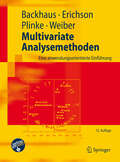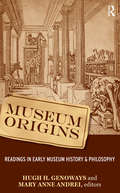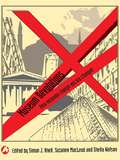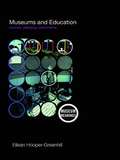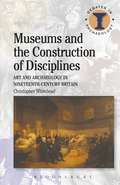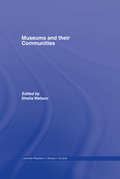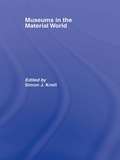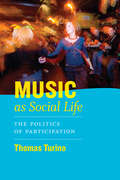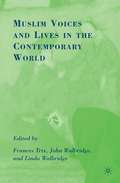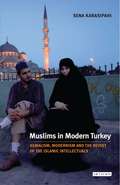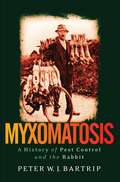- Table View
- List View
Multivariate Analysemethoden: Eine anwendungsorientierte Einführung (Springer-Lehrbuch)
by Klaus Backhaus Bernd Erichson Wulff Plinke Rolf WeiberMit der 12. Auflage des bewährten Lehrbuchs legen wir eine neue Konzeption vor. Wir haben den methodischen Inhalt erweitert, ohne die bisherigen Verfahren einzuschränken oder zu verdrängen. Da die Erweiterung das Buch jedoch nicht mehr handhabbar macht, haben wir uns entschieden, den Leserinnen und Lesern einen zweigeteilten Weg des Zugangs zu den verschiedenen Methoden zu verschaffen. Das neue Angebot besteht neben dem Buch mit den bewährten Verfahren im Zugang zu einer Internetplattform. Das Buch umfasst die „grundlegenden Verfahren der muen Analysemethoden" in ihrer bewährten Form sowie jeweils eine kurze ltivariatEinführung in die verschiedenen „komplexen Verfahren der multivariaten Analyse". Die Plattform gewährleistet den Zugang zu den komplexen Verfahren im Detail. Wir schaffen damit eine Erweiterung des Angebots bei gleichzeitiger Möglichkeit eines selektiven Zugangs zu den tatsächlich benötigten Verfahren. Die Fallbeispiele sind mit SPSS 16.0 gerechnet.
Museum Careers: A Practical Guide for Students and Novices
by N Elizabeth SchlatterThis concise volume is the place to start for anyone considering a career in museums. Museum professional and author N. Elizabeth Schlatter outlines the nature of the profession as a whole, the rewards and challenges of museum work, types of museums, and jobs within museums, including salary ranges. She discusses options for education and training, and offers suggestions on how to secure a job and move up the career ladder. Interviews with museum professionals from a variety of disciplines and backgrounds demonstrate different career paths and offer unique and helpful advice. For novices in the field, students in museum studies programs, or anyone considering museums as a career choice, Schlatter’s book is an essential starting point.
Museum Careers: A Practical Guide for Students and Novices
by N Elizabeth SchlatterThis concise volume is the place to start for anyone considering a career in museums. Museum professional and author N. Elizabeth Schlatter outlines the nature of the profession as a whole, the rewards and challenges of museum work, types of museums, and jobs within museums, including salary ranges. She discusses options for education and training, and offers suggestions on how to secure a job and move up the career ladder. Interviews with museum professionals from a variety of disciplines and backgrounds demonstrate different career paths and offer unique and helpful advice. For novices in the field, students in museum studies programs, or anyone considering museums as a career choice, Schlatter’s book is an essential starting point.
Museum Origins: Readings in Early Museum History and Philosophy
by Hugh H. Genoways Mary Anne AndreiWith the development of institutions displaying natural science, history, and art in the late 19th century came the debates over the role of these museum in society. This anthology collects 50 of the most important writings on museum philosophy dating from this formative period, written by the many of the American and European founders of the field. Genoways and Andrei contextualize these pieces with a series of introductions showing how the museum field developed within the social environment of the era. For those interested in museum history and philosophy or cultural history, this is an essential resource.
Museum Origins: Readings in Early Museum History and Philosophy
by Hugh H. Genoways Mary Anne AndreiWith the development of institutions displaying natural science, history, and art in the late 19th century came the debates over the role of these museum in society. This anthology collects 50 of the most important writings on museum philosophy dating from this formative period, written by the many of the American and European founders of the field. Genoways and Andrei contextualize these pieces with a series of introductions showing how the museum field developed within the social environment of the era. For those interested in museum history and philosophy or cultural history, this is an essential resource.
Museum Revolutions: How museums change and are changed
by Simon Knell Suzanne MacLeod Sheila WatsonThis single-volume museum studies reference title explores the ways in which museums are shaped and configured and how they themselves attempt to shape and change the world around them. Written by a leading group of museum professionals and academics from around the world and including new research, the chapters reveal the diverse and subtle means by which museums engage and in so doing change and are changed. The authors span over 200 years discussing national museums, ecomuseums, society museums, provincial galleries, colonial museums, the showman’s museum, and science centres. Topics covered include: disciplinary practices, ethnic representation, postcolonial politics, economic aspiration, social reform, indigenous models, conceptions of history, urban regeneration, sustainability, sacred objects, a sense of place, globalization, identities, social responsibility, controversy, repatriation, human remains, drama, learning and education. Capturing the richness of the museum studies discipline, Museum Revolutions is the ideal text for museum studies courses, providing a wide range of interlinked themes and the latest thought and research from experts in the field. It is invaluable for those students and museum professionals who want to understand the past, present and future of the museum.
Museums and Education: Purpose, Pedagogy, Performance (Museum Meanings)
by Eilean Hooper-GreenhillAt the beginning of the 21st century museums are challenged on a number of fronts. The prioritisation of learning in museums in the context of demands for social justice and cultural democracy combined with cultural policy based on economic rationalism forces museums to review their educational purposes, redesign their pedagogies and account for their performance. The need to theorise learning and culture for a cultural theory of learning is very pressing. If culture acts as a process of signification, a means of producing meaning that shapes worldviews, learning in museums and other cultural organisations is potentially dynamic and profound, producing self-identities. How is this complexity to be ‘measured’? What can this ‘measurement’ reveal about the character of museum-based learning? The calibration of culture is an international phenomenon, and the measurement of the outcomes and impact of learning in museums in England has provided a detailed case study. Three national evaluation studies were carried out between 2003 and 2006 based on the conceptual framework of Generic Learning Outcomes. Using this revealing data Museums and Education reveals the power of museum pedagogy and as it does, questions are raised about traditional museum culture and the potential and challenge for museum futures is suggested.
Museums and Education: Purpose, Pedagogy, Performance (Museum Meanings)
by Eilean Hooper-GreenhillAt the beginning of the 21st century museums are challenged on a number of fronts. The prioritisation of learning in museums in the context of demands for social justice and cultural democracy combined with cultural policy based on economic rationalism forces museums to review their educational purposes, redesign their pedagogies and account for their performance. The need to theorise learning and culture for a cultural theory of learning is very pressing. If culture acts as a process of signification, a means of producing meaning that shapes worldviews, learning in museums and other cultural organisations is potentially dynamic and profound, producing self-identities. How is this complexity to be ‘measured’? What can this ‘measurement’ reveal about the character of museum-based learning? The calibration of culture is an international phenomenon, and the measurement of the outcomes and impact of learning in museums in England has provided a detailed case study. Three national evaluation studies were carried out between 2003 and 2006 based on the conceptual framework of Generic Learning Outcomes. Using this revealing data Museums and Education reveals the power of museum pedagogy and as it does, questions are raised about traditional museum culture and the potential and challenge for museum futures is suggested.
Museums and the Construction of Disciplines: Art and Archaeology in Nineteenth-century Britain (Debates in Archaeology)
by Christopher WhiteheadMuseums and museum politics were important elements in the development of the disciplines of Archaeology and Art History in nineteenth-century Britain. Here Christopher Whitehead explores some of the key debates and events which led to the conceptual differentiation and physical separation of 'archaeological' and 'artistic' material culture, looking especially at the ways in which objects and histories were contested within museum politics. For example, in the 1850s, the status of Egyptian antiquities as 'art' or 'archaeology' was keenly debated, and this related closely to questions about which kinds of museum should house them and the possible histories and epistemologies in which they might figure. This concise study serves as a basis for a discussion of the continued intellectual legacy of this for our understanding, management and presentation of the past in the museum and in curricula. It is argued that by understanding the politics and circumstances through which the two disciplines were delimited and distinguished from one another we may be able to glimpse, retrospectively, the possibility of alternative art histories and alternative archaeologies.
Museums and their Communities (Leicester Readers in Museum Studies)
by Sheila WatsonUsing case studies drawn from all areas of museum studies, Museums and their Communities explores the museums as a site of representation, identity and memory, and considers how it can influence its community. Focusing on the museum as an institution, and its social and cultural setting, Sheila Watson examines how museums use their roles as informers and educators to empower, or to ignore, communities. Looking at the current debates about the role of the museum, she considers contested values in museum functions and examines provision, power, ownership, responsibility, and institutional issues. This book is of great relevance for all disciplines as it explores and questions the role of the museum in modern society.
Museums and their Communities (Leicester Readers in Museum Studies)
by Sheila WatsonUsing case studies drawn from all areas of museum studies, Museums and their Communities explores the museums as a site of representation, identity and memory, and considers how it can influence its community. Focusing on the museum as an institution, and its social and cultural setting, Sheila Watson examines how museums use their roles as informers and educators to empower, or to ignore, communities. Looking at the current debates about the role of the museum, she considers contested values in museum functions and examines provision, power, ownership, responsibility, and institutional issues. This book is of great relevance for all disciplines as it explores and questions the role of the museum in modern society.
Museums in the Material World (Leicester Readers in Museum Studies)
by Simon KnellMuseums in the Material World seeks to both introduce classic and thought-provoking pieces and contrast them with articles which reveal grounded practice. The articles are selected from across the full breadth of museum disciplines and are linked by a logical narrative, as detailed in the section introductions. The choice of articles reveals how the debate has opened up on disciplinary practice, how the practices of the past have been critiqued and in some cases replaced, how it has become necessary to look beyond and outside disciplinary boundaries, and how old practices can in many circumstances continue to have validity. Museums in the Material World is about broadening horizons and moving museum studies students, and others, beyond the narrow confines of their own disciplinary thinking or indeed any narrow conception of collections. In essence, this is a book about the practice of interpretation and will therefore be of great use to those students and museum practitioners involved in the field of material culture in museums.
Museums in the Material World (Leicester Readers in Museum Studies)
by Simon KnellMuseums in the Material World seeks to both introduce classic and thought-provoking pieces and contrast them with articles which reveal grounded practice. The articles are selected from across the full breadth of museum disciplines and are linked by a logical narrative, as detailed in the section introductions. The choice of articles reveals how the debate has opened up on disciplinary practice, how the practices of the past have been critiqued and in some cases replaced, how it has become necessary to look beyond and outside disciplinary boundaries, and how old practices can in many circumstances continue to have validity. Museums in the Material World is about broadening horizons and moving museum studies students, and others, beyond the narrow confines of their own disciplinary thinking or indeed any narrow conception of collections. In essence, this is a book about the practice of interpretation and will therefore be of great use to those students and museum practitioners involved in the field of material culture in museums.
Music as Social Life: The Politics of Participation (Chicago Studies in Ethnomusicology)
by Thomas TurinoPeople around the world and throughout history have used music to express their inner emotions, reach out to the divine, woo lovers, celebrate weddings, inspire political movements, and lull babies to sleep. In Music as Social Life, Thomas Turino explores why it is that music and dance are so often at the center of our most profound personal and social experiences. Turino begins by developing tools to think about the special properties of music and dance that make them fundamental resources for connecting with our own lives, our communities, and the environment. These concepts are then put into practice as he analyzes various musical examples among indigenous Peruvians, rural and urban Zimbabweans, and American old-time musicians and dancers. To examine the divergent ways that music can fuel social and political movements, Turino looks at its use by the Nazi Party and by the American civil rights movement. Wide-ranging, accessible to anyone with an interest in music’s role in society, and accompanied by a compact disc, Music as Social Life is an illuminating initiation into the power of music.
Music of the Postwar Era (American History through Music)
by Don TylerAt the end of WWII, themes in music shifted from soldiers' experiences at war to coming home, marrying their sweethearts, and returning to civilian life. The music itself also shifted, with crooners such as Bing Crosby and Frank Sinatra replacing the Big Bands of years past. Country music, jazz, and gospel continued to evolve, and rhythm and blues and the new rock and roll were also popular during this time. Music is not created without being influenced by the political events and societal changes of its time, and the Music of the Postwar Era is no exception.*includes combined musical charts for the years 1945-1959 *approximately 20 black and white images of the singers and musicians who represent the era's music
Muslim Voices and Lives in the Contemporary World
by F. Trix J. WalbridgeThis book tells the stories of eleven remarkable people in the Islamic world, from a religious musician in Pakistan who sings the sufferings of the saints and hopes to bring reconciliation to his country, to the son of one of the greatest Shi'ite scholars of Iraq who was murdered trying to restore peace in his city.
Muslims in Modern Turkey: Kemalism, Modernism and the Revolt of the Islamic Intellectuals (Library of Modern Middle East Studies)
by Sena KarasipahiModern Turkey is the site of a powerful Islamic revival, with a strong intellectual elite dedicated to the overthrow of secular modernism. Why have modern Muslim intellectuals turned against the ideals of Kemalism on which the modern Turkish nation-state is founded? What does this reveal about the future of Turkey? And how are Islamic intellectuals in Turkey affected by developments in the Middle East?Muslims in Modern Turkey is the first book to analyse this phenomenon, tracing the evolution of Muslim intellectual thought from the 1980s to the present day. It focuses on six leading Muslim thinkers - Ali Bulaç, Rasim Özdenören, ?smet Özel, ?lhan Kutluer, Ersin Nazif Gürdo?an and Abdurrahman Dilipak - who belong to a single school and share a novel understanding of Islam. They act as public intellectuals, who aim to reform and enlighten society by educating them and raising their awareness of Islamic values, arguing not for the compatibility of Islam and European values but the fundamental superiority of Islam over secular democracy.Sena Karasipahi places the Turkish experience in its broader international context and shows how Turkish Islamic intellectuals are affected by the earlier Muslim intellectuals and revivalists in the Arab world and in Turkey. This important study makes connections with the Islamic revival process throughout the contemporary Middle East as well as with comparable movements in Turkey's own past, making this a crucial contribution to an understanding of contemporary Islamic political thinking.
Muslims on the Map: A National Survey of Social Trends in Britain
by Serena HussainMany faith groups in the UK - most notably Muslims - have in recent years challenged the idea that religion should be predominantly a matter for the private domain. In response to this challenge, the 2001 National Census included the question of religious affiliation. Using the large-scale data of the 2001 National Census, "Muslims on the Map" has created the first long awaited community profile which looks at Muslims as an entire faith community from a sociological and social policy perspective. In her analysis, Serena Hussain reveals the social position of Muslims as a group compared to other faith communities in terms of educational qualifications, economic activity and housing conditions and as demonstrated by other poverty indicators. In doing so, she provides the first significant, comprehensive portrait of Muslim communities in modern Britain.
The Myth of the Chemical Cure: A Critique of Psychiatric Drug Treatment
by J. MoncrieffThis book overturns the idea that psychiatric drugs work by correcting chemical imbalance and analyzes the professional, commercial and political vested interests that have shaped this view. It provides a comprehensive critique of research on drugs including antidepressants, antipsychotics and mood stabilizers.
Myxomatosis: A History of Pest Control and the Rabbit (International Library of Twentieth Century History)
by Peter W.J. BartripMyxomatosis, a viral disease of European wild rabbits, was discovered in South America in the 1890s. It was deliberately introduced in Australia and France in the 1950s and reached Britain in 1953. Within a year it had killed tens of millions of rabbits from Kent to the Shetlands. The British reaction to myxomatosis was mixed; members of the public reared on the tales of Beatrix Potter were appalled. With meat still rationed, consumers deplored the loss of a cheap and nutritious foodstuff. Many farmers, on the other hand, welcomed the rabbit's demise as a serious agricultural pest and actively spread the disease.However some lost their livelyhood through the spread of Myxomatosis, such as rough shooters who regretted the loss of prey and hatters and furriers who mourned the unavailability of the fur on which they depended. Rabbits also had champions within the 'establishment'; including Winston Churchill and the Archbishop of York, who both regarded myxomatosis as an abomination. Winston Churchill was personally influential in making its deliberate transmission a criminal offence. Even the farmers and foresters who applauded the rabbit's demise often had qualms about a disease that inflicted such a horrible death. Myxomatosis presented the authorities with difficult questions: should they try to contain the disease, encourage it, or do nothing? Should they take advantage of rabbit depopulation and try to exterminate the animal? Britain's myxomatosis outbreak has hitherto attracted little historical attention, notwithstanding parallels with other recent animal disease crises. In the first book dedicated to this subject, Peter Bartrip examines how the disease reached Britain. He argues it was not the government who was reesponsible, as many thought at the time, but instead identifies the individual who may have deliberatlely brought myxomatosis over from France. Bartrip tracks the spread of the virus throughout the country and considers the response of government and other bodies and the impact of rabbit de-population on agriculture and the natural environment. The cultural significance of myxomatosis in Britain raises topical and controversial issues relating to veterinary medicine, animal rights, the interface between human and animal health, the ethics of pest control by biological means and the politics of environmental meddling. These are important considerations if we are to learn lessons from more recent animal disease crises such as foot and mouth, BSE and H5N1 avian influenza.
Nachwuchsförderung im Sport: Ein Beitrag zur Analyse und Entwicklung der Nachwuchsförderung in der Schweiz aus systemtheoretischer Sicht
by Frank HeinzmannFrank Heinzmann analysiert die Nachwuchsförderung in der Schweiz aus systemtheoretischer Perspektive. Die Überprüfung erfolgt durch ein Modell, das ein kybernetisches Design verwendet. 22 Variablen mit unterschiedlicher Wirkungsweise werden als systemrelevant und zentral eingestuft.
Narrating Media History
by Michael BaileyBased on the work of media historian, James Curran, Narrating Media History explores British media history as a series of competing narratives. This unique and timely collection brings together leading international media history scholars, not only to identify and contrast the various interrelationships between media histories, but also to encourage dialogue between different historical, political, and theoretical perspectives including: liberalism, feminism, populism, nationalism, libertarianism, radicalism and technological determinism. Essays by distinguished academics cover television, radio, newspaper press and advertising (among others) and illustrate the particularities, affinities, strengths and weaknesses within media history Each section includes a brief introduction by the editor, with discussion topics and suggestions for further reading, making this an invaluable guide for students of media history.
Narrating Media History (Communication and Society)
by Michael BaileyBased on the work of media historian, James Curran, Narrating Media History explores British media history as a series of competing narratives. This unique and timely collection brings together leading international media history scholars, not only to identify and contrast the various interrelationships between media histories, but also to encourage dialogue between different historical, political, and theoretical perspectives including: liberalism, feminism, populism, nationalism, libertarianism, radicalism and technological determinism. Essays by distinguished academics cover television, radio, newspaper press and advertising (among others) and illustrate the particularities, affinities, strengths and weaknesses within media history. Each section includes a brief introduction by the editor, with discussion topics and suggestions for further reading, making this an invaluable guide for students of media history.
Narrating Media History (Communication and Society)
by Michael BaileyBased on the work of media historian, James Curran, Narrating Media History explores British media history as a series of competing narratives. This unique and timely collection brings together leading international media history scholars, not only to identify and contrast the various interrelationships between media histories, but also to encourage dialogue between different historical, political, and theoretical perspectives including: liberalism, feminism, populism, nationalism, libertarianism, radicalism and technological determinism. Essays by distinguished academics cover television, radio, newspaper press and advertising (among others) and illustrate the particularities, affinities, strengths and weaknesses within media history. Each section includes a brief introduction by the editor, with discussion topics and suggestions for further reading, making this an invaluable guide for students of media history.
Narrating Media History (PDF)
by Michael BaileyBased on the work of media historian, James Curran, Narrating Media History explores British media history as a series of competing narratives. This unique and timely collection brings together leading international media history scholars, not only to identify and contrast the various interrelationships between media histories, but also to encourage dialogue between different historical, political, and theoretical perspectives including: liberalism, feminism, populism, nationalism, libertarianism, radicalism and technological determinism. Essays by distinguished academics cover television, radio, newspaper press and advertising (among others) and illustrate the particularities, affinities, strengths and weaknesses within media history Each section includes a brief introduction by the editor, with discussion topics and suggestions for further reading, making this an invaluable guide for students of media history.
